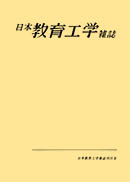Volume 10, Issue 4
Displaying 1-16 of 16 articles from this issue
- |<
- <
- 1
- >
- >|
-
Article type: Cover
1986 Volume 10 Issue 4 Pages Cover1-
Published: December 20, 1986
Released on J-STAGE: October 20, 2017
Download PDF (23K) -
Article type: Cover
1986 Volume 10 Issue 4 Pages Cover2-
Published: December 20, 1986
Released on J-STAGE: October 20, 2017
Download PDF (23K) -
Article type: Appendix
1986 Volume 10 Issue 4 Pages App1-
Published: December 20, 1986
Released on J-STAGE: October 20, 2017
Download PDF (77K) -
Article type: Appendix
1986 Volume 10 Issue 4 Pages App2-
Published: December 20, 1986
Released on J-STAGE: October 20, 2017
Download PDF (77K) -
Article type: Article
1986 Volume 10 Issue 4 Pages 1-11
Published: December 20, 1986
Released on J-STAGE: October 20, 2017
Download PDF (1140K) -
Article type: Article
1986 Volume 10 Issue 4 Pages 13-21
Published: December 20, 1986
Released on J-STAGE: October 20, 2017
Download PDF (909K) -
Article type: Article
1986 Volume 10 Issue 4 Pages 23-33
Published: December 20, 1986
Released on J-STAGE: October 20, 2017
Download PDF (1060K) -
Article type: Article
1986 Volume 10 Issue 4 Pages 35-40
Published: December 20, 1986
Released on J-STAGE: October 20, 2017
Download PDF (762K) -
Article type: Index
1986 Volume 10 Issue 4 Pages 41-
Published: December 20, 1986
Released on J-STAGE: October 20, 2017
Download PDF (59K) -
Article type: Index
1986 Volume 10 Issue 4 Pages 42-
Published: December 20, 1986
Released on J-STAGE: October 20, 2017
Download PDF (66K) -
Article type: Appendix
1986 Volume 10 Issue 4 Pages App3-
Published: December 20, 1986
Released on J-STAGE: October 20, 2017
Download PDF (14K) -
Article type: Appendix
1986 Volume 10 Issue 4 Pages App4-
Published: December 20, 1986
Released on J-STAGE: October 20, 2017
Download PDF (94K) -
Article type: Appendix
1986 Volume 10 Issue 4 Pages App5-
Published: December 20, 1986
Released on J-STAGE: October 20, 2017
Download PDF (94K) -
Article type: Appendix
1986 Volume 10 Issue 4 Pages App6-
Published: December 20, 1986
Released on J-STAGE: October 20, 2017
Download PDF (94K) -
Article type: Cover
1986 Volume 10 Issue 4 Pages Cover3-
Published: December 20, 1986
Released on J-STAGE: October 20, 2017
Download PDF (24K) -
Article type: Cover
1986 Volume 10 Issue 4 Pages Cover4-
Published: December 20, 1986
Released on J-STAGE: October 20, 2017
Download PDF (24K)
- |<
- <
- 1
- >
- >|
